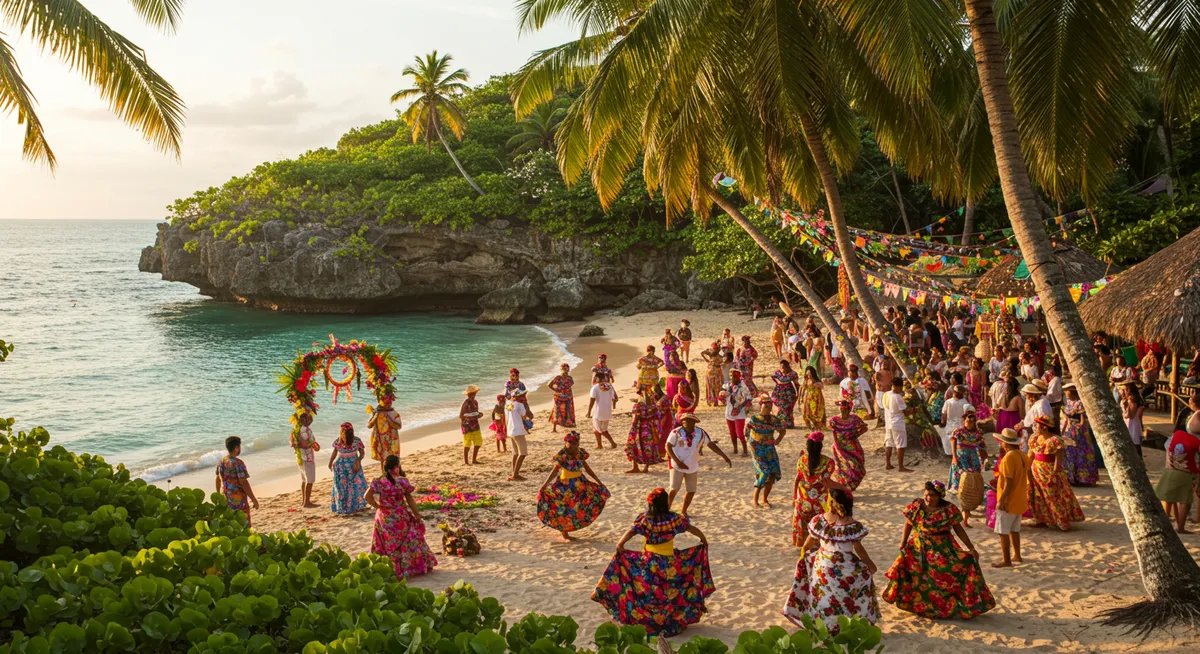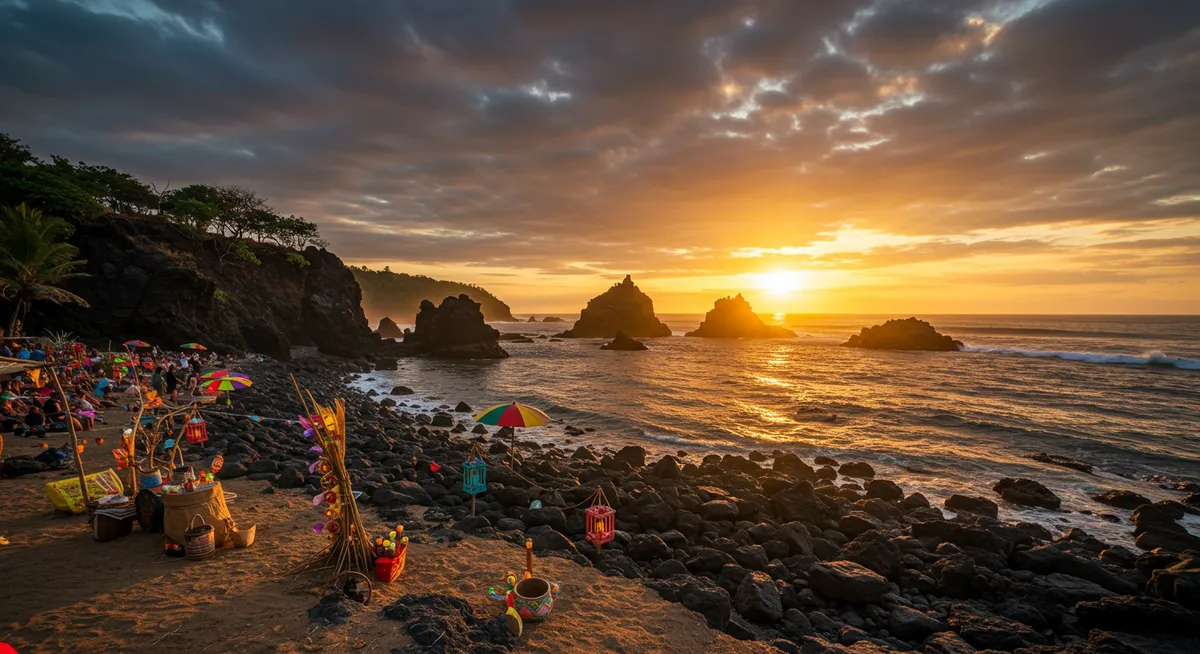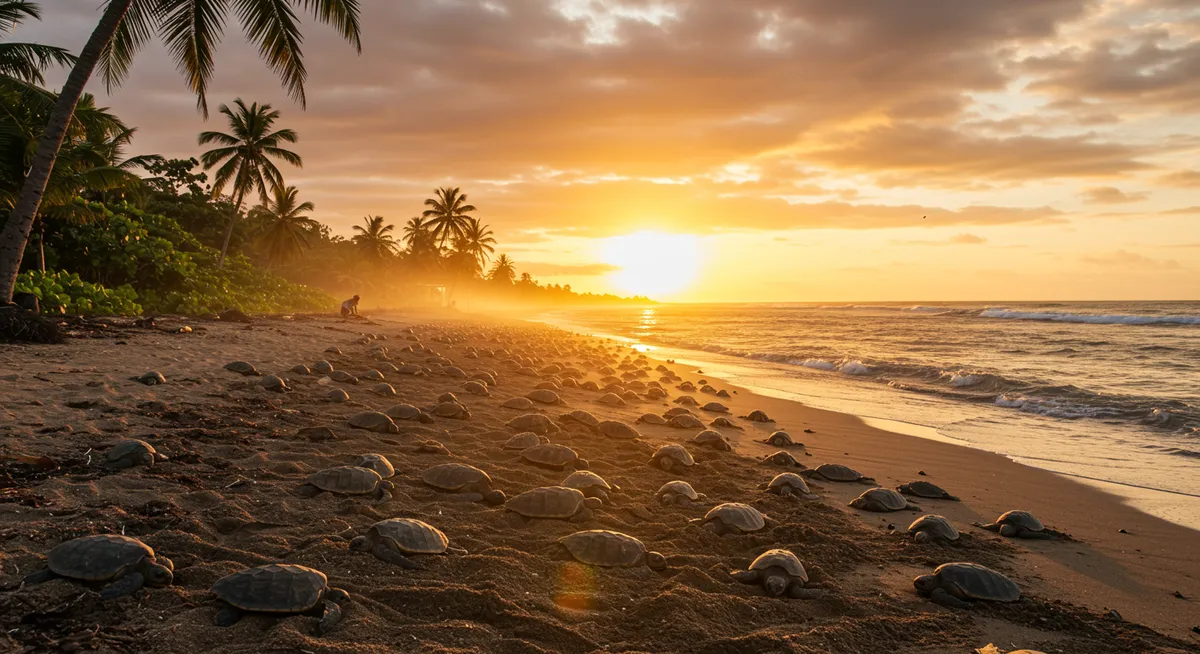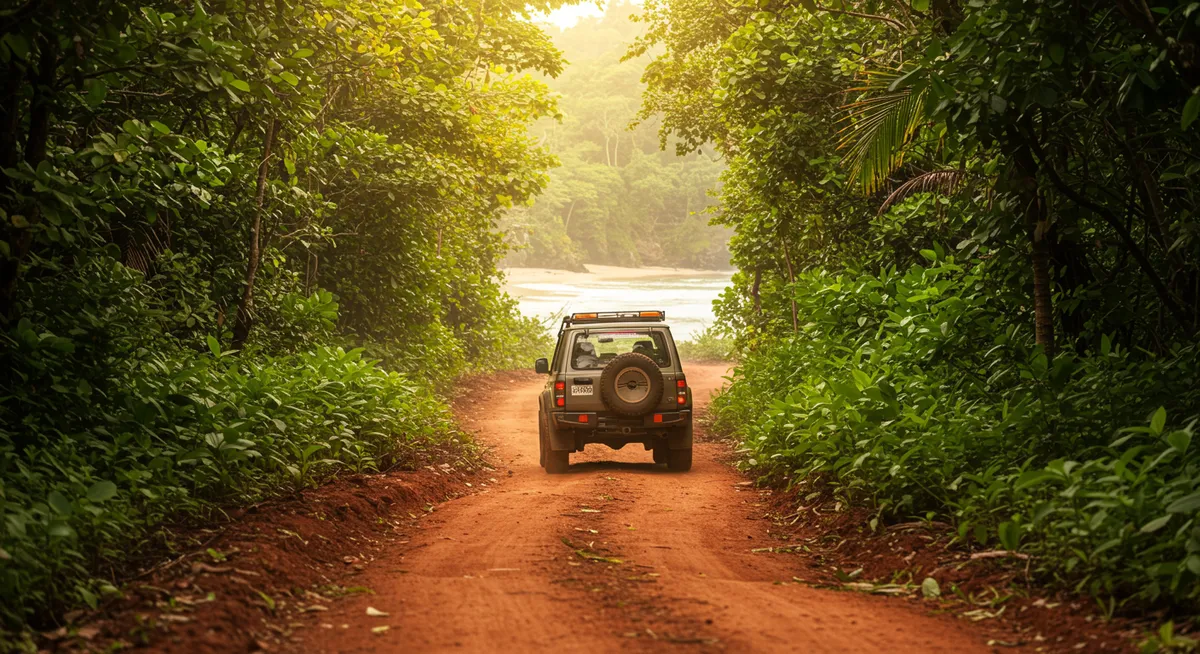Wild Beaches of Central America's Pacific Coast

Wild Beaches of Central America's Pacific Coast
The Pacific coastline of Central America stretches for thousands of miles, from Mexico's southern border to Panama's edge at Colombia. While the region's Caribbean shores often capture more tourist attention, it's along the Pacific where travelers find the most dramatic and untamed beach landscapes—thundering surf, volcanic black sand, nesting sea turtles, and sunsets that transform the ocean into a canvas of fiery colors. Beyond the developed beaches of tourist hubs like Tamarindo and San Juan del Sur lie hidden coastal treasures that remain gloriously wild and uncrowded.

Why Central America's Pacific Secret Beaches Stand Apart
The secret beaches along Central America's Pacific edge offer distinctive characteristics that differentiate them from other coastal regions:
- Dramatic Topography: Volcanic landscapes, sea caves, rugged cliffs, and mountainous backdrops create visual spectacles
- Ecological Diversity: Convergence of northern and southern marine ecosystems creates exceptional biodiversity
- Wildlife Encounters: Frequent opportunities to witness sea turtles nesting, whales migrating, and monkeys traversing beach forests
- Natural Energy: Powerful Pacific swells create beaches with character—from surfing havens to protected tide pools
- Cultural Authenticity: Indigenous and traditional fishing communities maintain centuries-old relationships with coastal areas
Nicaragua's Undiscovered Pacific Shores
Despite having the longest coastline in Central America, Nicaragua's Pacific beaches remain remarkably underdeveloped, offering authentic experiences for travelers seeking solitude and natural beauty.
Playa Gigante
This crescent-shaped bay with golden sand has maintained its small fishing village character despite Nicaragua's growing tourism. Backed by densely forested hills, the beach offers exceptional sunset views over distinctive offshore rock formations. The peaceful shore break makes it suitable for swimming, unlike many Pacific beaches with dangerous currents.
How to Get There: A bumpy dirt road connects to the main highway between Rivas and Tola. Four-wheel drive recommended during rainy season.
Insider Tip: Follow the jungle trail at the north end of the beach to reach Playa Amarillo, an even more secluded stretch of sand that often has no other visitors.
Playa Jiquilillo
Nearly 9 miles of uninterrupted golden sand in northwestern Nicaragua remains virtually unknown to international tourists. This straight stretch of coast offers epic sunsets, excellent beachcombing, and a glimpse into authentic coastal Nicaraguan life in the small fishing community. The beach features a turtle hatchery where visitors can sometimes help release baby turtles.
How to Get There: Take a bus from Chinandega and transfer to a shared taxi for the final stretch.
Insider Tip: The beach breaks here create gentle waves perfect for beginner surfers without the crowds found at more popular surf spots.
Playa El Coco, Chacocente Wildlife Refuge
Within this protected natural area south of Managua, Playa El Coco offers a wild, undeveloped beach important for olive ridley sea turtle nesting. Between July and January, thousands of turtles arrive for mass nesting events called arribadas. The dark sand beach stretches for miles with no development apart from a small research station.
How to Get There: Four-wheel drive required for the rough access road from Diriamba.
Insider Tip: Visit during the waning moon period in sea turtle season (August-November) for the best chance to witness arribadas, but arrange in advance as visitor numbers are controlled.

Costa Rica's Secret Pacific Gems
Despite its well-developed tourism industry, Costa Rica still harbors Pacific beaches that remain off the standard tourist circuit, offering wilderness experiences alongside exceptional biodiversity.
Playa San Juanillo
On the Nicoya Peninsula, this double-bay beach with bright white sand creates a stark contrast to the turquoise waters and green tropical forest surrounding it. A distinctive tombolo (sand formation connecting to an islet) creates two separate beach areas with different wave conditions. The small fishing village maintains an authentic Costa Rican atmosphere.
How to Get There: A partially paved road connects from the Nosara-Ostional highway. The last sections may require 4WD during rainy season.
Insider Tip: The northern cove offers protected swimming conditions unusual for Pacific beaches, while the southern side provides more powerful waves for surfing.
Playa Barrigona
Made famous as Mel Gibson's former property but still remarkably undeveloped, this golden sand beach near Samara features powerful surf, stunning rock formations, and dense jungle extending nearly to the water's edge. Howler monkeys frequently travel through the trees overlooking the beach.
How to Get There: Four-wheel drive essential for the steep, rutted jungle road from Samara.
Insider Tip: Visit during early morning hours when tide pools form on the southern end, creating natural swimming areas safe from the strong current.
Playa Caletas, Osa Peninsula
This remote black-sand beach within Costa Rica's most biodiverse region offers an extraordinary wilderness experience. Where Corcovado National Park meets the Pacific Ocean, this isolated shore provides frequent wildlife sightings including scarlet macaws, four species of monkeys, and nesting sea turtles depending on the season.
How to Get There: Accessible only by boat from Drake Bay or via a challenging hike through the national park (permit required).
Insider Tip: The beach forms part of a sea turtle conservation project; visitors can arrange in advance to participate in nocturnal monitoring patrols during nesting season.
Playa Arco, Uvita
Named for the natural stone arch that frames this small pocket beach, Playa Arco requires effort to reach but rewards visitors with a perfectly secluded cove. Located within Marino Ballena National Park but away from its more visited areas, the beach features soft golden sand, natural shade from coastal almond trees, and excellent snorkeling when conditions permit.
How to Get There: A 30-minute hike through jungle and along rocky coastline from Playa Ballena.
Insider Tip: Time your visit for low tide when you can easily navigate around coastal rocks and explore the sea caves near the arch.
Panama's Hidden Pacific Coastlines
Panama's unique geography creates one of Central America's most varied Pacific coastlines, with beaches ranging from island paradises to wild, surf-pounded shores—many still flying under the tourist radar.
Playa Venao
While gaining attention in surf circles, this horseshoe-shaped bay on the Azuero Peninsula remains pleasantly uncrowded compared to its potential. The consistent waves draw surf enthusiasts, but the nearly two-mile crescent of sand offers plenty of space for everyone. Backed by rolling hills rather than development, the beach maintains a natural feel.
How to Get There: A recently improved road connects from Las Tablas, about four hours from Panama City.
Insider Tip: The beach's eastern end offers gentler waves for beginners, while experienced surfers head to the western point break.
Playa Cambutal
At the southernmost point of the Azuero Peninsula, this remote black sand beach marks the end of the road—literally. The powerful shore break and strong currents make swimming challenging but create dramatic coastal scenery as waves thunder against volcanic rock formations. The area serves as an important leatherback turtle nesting site.
How to Get There: The journey requires navigating increasingly rural roads from Las Tablas to Tonosí and then onward to Cambutal.
Insider Tip: The beach faces almost directly south, creating the rare opportunity on Panama's Pacific coast to watch both sunrise and sunset over the water at different times of year.
Isla Secas
This private archipelago of 16 small islands in the Gulf of Chiriquí offers some of Panama's most pristine beaches, accessible only to overnight guests of the exclusive eco-resort or by private yacht. The white sand shores remain in nearly perfect condition, with exceptional marine life in the surrounding protected waters.
How to Get There: Private boat transfer from Punta Balsa near Boca Chica, which is reached by road from David.
Insider Tip: Despite the luxury price tag, the resort limits capacity to just 18 guests, ensuring beaches remain nearly private. The islands focus heavily on conservation with 75% of the archipelago left undeveloped.
Santa Catalina's Hidden Coves
While Santa Catalina has gained recognition among surfers, the small neighboring beaches to the north and south remain largely unexplored. These hidden coves, accessible by boat or jungle trails, offer secluded stretches of dark sand backed by jungle and fronted by rocky tidepools teeming with marine life.
How to Get There: From Santa Catalina village, hire a local fisherman or walk along the shoreline at low tide.
Insider Tip: Playa Brava, reached by a 45-minute jungle hike, offers exceptional seclusion and powerful waves—bring sufficient water and supplies as there are no facilities.
El Salvador's Under-the-Radar Beaches
Often overlooked by international travelers, El Salvador's Pacific coastline offers exceptional beach experiences with a fraction of the visitors found in neighboring countries.
Playa El Zonte
Before becoming known for its Bitcoin experiment, this rugged beach was cherished by surfers for its consistent right point break and laid-back atmosphere. The dark sand beach is framed by dramatic cliffs and remains refreshingly undeveloped compared to nearby El Tunco. A small, tight-knit community of locals and expats maintains the area's relaxed character.
How to Get There: Located off the coastal highway between La Libertad and El Tunco, approximately one hour from San Salvador.
Insider Tip: The natural rock pools at the beach's northern end offer safe swimming areas during low tide when the main beach has strong currents.
Playa Las Flores
On El Salvador's eastern coast near the Gulf of Fonseca, this remote golden sand beach offers world-class surfing in a remarkably undeveloped setting. The bay's distinctive point break creates perfect right-hand waves, while the surrounding tropical dry forest supports diverse wildlife including parrots and iguanas.
How to Get There: A rough road leads to the beach from El Cuco, approximately 3.5 hours from San Salvador.
Insider Tip: Morning glassy conditions provide the best surfing, while dramatic electrical storms over the Pacific create spectacular evening light shows during the May-November rainy season.
Essential Tips for Central American Pacific Beaches
Ocean Safety
Pacific beaches in Central America require respect and caution:
- Powerful Currents: Many beaches have strong rip currents and undertow—always ask locals about conditions
- Limited Lifeguards: Most secret beaches have no supervision or emergency services
- Tide Awareness: Dramatic tidal variations can trap unwary visitors on some beaches
- Lightning Risk: Afternoon electrical storms during rainy season pose dangers—seek shelter when storms approach
Seasonal Considerations
Central America's climate patterns significantly impact beach experiences:
- Dry Season (December-April): Ideal beach conditions with sunshine, minimal rainfall, and easier access roads
- Green/Rainy Season (May-November): Lush landscapes and fewer visitors, but afternoon thunderstorms and potential access difficulties
- Turtle Nesting: July-December offers the best opportunities to witness turtle nesting on many beaches
- Surf Conditions: Largest swells typically occur March-October with more beginner-friendly waves November-February
Access Challenges
Reaching Central America's secret beaches often requires determination:
- Rental Vehicles: High-clearance 4WD vehicles essential for many beach access roads
- Road Conditions: Unpaved roads may become impassable during heavy rains
- Local Knowledge: Many beach access points are unmarked—seek local guidance
- Public Transportation: Limited or nonexistent to truly remote beaches

Environmental and Cultural Responsibility
Central America's Pacific coast faces increasing environmental pressures that visitors can help mitigate through responsible practices:
Environmental Considerations
- Respect turtle nesting sites by maintaining distance and avoiding lights at night
- Pack out all trash, as many remote areas have no waste management facilities
- Use reef-safe sunscreen to protect marine ecosystems
- Follow established trails to prevent erosion on coastal slopes
Cultural Sensitivity
- Many beaches neighbor indigenous communities with traditional relationships to coastal resources
- Ask permission before photographing local people or fishing activities
- Respect fishing equipment and boats on working beaches
- Support community-based tourism initiatives that benefit local economies
Accommodations Near Secret Beaches
Lodging options near remote Central American beaches range from rustic to eco-luxe:
Eco-Lodges
The most common accommodation type near secret beaches, these sustainable properties range from basic to high-end, typically offering:
- Open-air designs that maximize natural cooling
- Limited or solar electricity and rainwater collection systems
- Organic gardens supplying on-site restaurants
- Integration with local conservation initiatives
Glamping and Beach Camping
For truly immersive experiences, consider:
- Beachfront glamping tents with proper beds but minimal infrastructure
- Legal beach camping areas (always obtain permission)
- Surf camps offering basic accommodations focused on wave access
Vacation Rentals
In more remote coastal areas:
- Simple beach houses available through local contacts rather than major platforms
- Off-grid properties requiring self-sufficiency
- Longer minimum stays often required due to remote locations
Beyond the Beach: Central America's Coastal Ecosystems
The areas surrounding secret beaches often harbor remarkable ecosystems worth exploring:
Mangrove Forests
These critical transition zones between land and sea offer:
- Kayaking opportunities through tranquil channels
- Bird watching with species ranging from magnificent frigatebirds to roseate spoonbills
- Glimpses of American crocodiles and caimans in protected waterways
Dry Tropical Forests
Unique to the Pacific coast, these forests feature:
- Distinctive tree species adapted to seasonal drought
- High concentrations of wildlife, particularly during dry season
- Hiking trails with panoramic coastal viewpoints
Volcanic Landscapes
The Pacific's "Ring of Fire" creates distinctive coastal features:
- Dramatic headlands where lava flows meet ocean
- Natural hot springs emerging on certain beaches
- Distinctive black sand composed of crushed volcanic rock
The Future of Central America's Secret Beaches
Central America's Pacific coast stands at a crossroads, with development pressure increasing alongside conservation awareness. Many of the most extraordinary hidden beaches remain protected by their difficult access, national park status, or community stewardship programs. Yet others face threats from large-scale tourism development, agricultural runoff, and climate change impacts including sea level rise and coral bleaching.
By visiting thoughtfully—choosing eco-conscious accommodations, respecting local communities, supporting conservation initiatives, and treading lightly on these precious shores—travelers can help ensure these wild beaches remain pristine for future generations. The reward for those making the effort to discover these hidden coastlines is immeasurable: experiences of nature at its most powerful and beautiful, connections to traditional coastal cultures, and memories of beaches as they have existed for millennia—wild, dynamic, and free from crowds.
Planning your Central American beach adventure?
Discover more secret beaches and travel inspiration in our comprehensive guides: